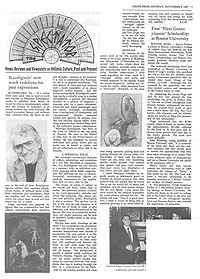
Katafigiotis' new work redefines his past expressions
Greek Press, Monday, November 9, 1987
- A.C.D.

RUTHERFORD, NJ - If a visitor from outer space were to land on earth and wander in Menelaos Katafigiotis' studio in suburban New Jersey, he would be able to simultaneously experience the essence of humanity at its purest, noblest and most innocent. He would encounter heroes and ordinary men, creatures from the dawn of history to the end of time. Katafigiotis' figures, whether they represent people, proud horses, or delicate birds, evoke both memories and prophesies, both the familiar and the unknown, that which has always been around and that which has yet to come.
Large canvases are peopled by figures that are contemplative and that silently communicate plain emotions and thoughts common to all mankind. It is easy to understand why Katafigiotis' art is so popular worldwide. The lyric beauty of color and line contrasts with a harsh materiality of an almost engraved surface texture. Just like human nature itself, Katafigiotis' paintings can be a colorful song or a somber introspection, a painful and distorted moment or a picture of elegance, a dramatic play or a poem whispered. Child-like and direct personages stare out openly, invitingly, un-abashedly from a background of timelessness and "spacelessness". Simple, perennial actions and gestures by archaic, icon-like and hierratic figures reflect something primeval that reaches deep within the collective human subconscious.
Menelaos Katafigiotis was born in the town of Trikala in the vast plain of Thessaly. He went to the School of Fine Arts of the Polytechneion of Athens. He has exhibited in several individual and group shows and his works can be found in public and private collections on either side of the Atlantic.
A PERSONAL STYLE
His technique incorporates elements of cubism, primitivism and symbolism in a way best described as expressionism. Yet, Katafigiotis has also arrived at a personal style, an individual symbolic language which defies categorization. His paintings are easy to identify. Sculptural, monumental figures are carefully constructed by the application, first of color, then of line.
The choice of colors is subject to his moods and ideas, rather than to reality .His preferred palette, contrary to his warm personality, includes cool colors like turquoise, lilac, lemon yellow and pistachio green. Katafigiotis is also a sculptor. This quality can be felt by the way he uses pigment, as if it were clay or stone, in order to give substance and three-dimensionality to his figures. His love of sculpturally poised, static and plastic positions and his lack of narrative further attest to his sculptural aspect.
Having seen early drawings of the artist, I can comprehend his attachment to line and strong outlines. He is an excellent draughtsman who chooses to manipulate line and submit it to his will. Sometimes lines will act as leaders to the viewer's eye. At other times they will confound and fracture the form. At still other times line will take on a life of its own, wiry, tense, full of energy. The background is usually a neutral plane, recalling the Thessalic flatness. Figures are "carved out" by sharp, incisive strokes that create an elaborate network. One often thinks that one is looking through the skin, at a cross-section of the body, with all the muscles, tendons and veins.
As if all this meticulously worked surface was not elaborate enough, Katafigiotis sometimes superimposes stencil like patterns which additionally enrich the relief-like "wrought" appearance and which expound on the impression of an onieric landscape.
Katafigiotis admires Van Gogh very much but feels that he has not been directly influenced by any one artist. He has gone through no distinct stylistic phases or periods, instead, his style has been gradually developing.
NEW TENDENCIES
This has been the essence of the artist's work so far. His exhibition at the Zygos gallery of Washington (November l2 - December 6, 1987) has several new works which show his recent tendency towards more clarity and simplification both of content and form. Another observation I have made regarding his latest work is a "Baroque" energy and active and twisted positions of the figures. Forms are placed diagonally "jutting out" towards the viewer, often presented from a "bird's-eye" viewpoint, at the same time rising upwards, pulling back and poking through the picture plane (see illustration of nude with hat above.) There are also some very interesting smaller works painted with enamel that sparkle and glow with warmer than usual colors (see illustration of two horses and one figure above).
I asked Menelaos whether he regards people as inherently good, or whether he simply portrays only their positive side. He replied that he would like to see the world full of peace and inhabited only by kind human beings, like his own figures. I also asked him what would be the ultimate expression he could achieve through his art. He smiled and said, "That is a good question. I think it would be being able to continue growing as an artist while remaining true and constant to myself and my ideals and seeing my work expressing both this development and this stability.
